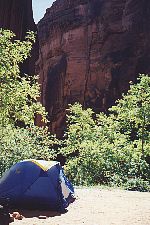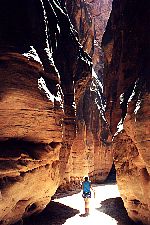 Paria Canyon and Buckskin Gulch
Paria Canyon and Buckskin Gulch
Click on any image to enlarge.
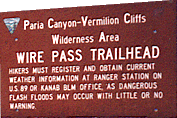 Paria Canyon (pronounced "pah-ree'-ah"), located on the Arizona-Utah border, provides one of the best canyoneering opportunities in the West.
Extending 38 miles through the Paria Canyon-Vermillion Cliffs wilderness, the hike from White House trailhead to Lees Ferry offers an outstanding variety of
canyon scenery. The fabulous Buckskin Gulch is a tributary to the Paria River and connects with the Paria at a spot known as "the Confluence", located
directly on the Arizona-Utah border. Buckskin Gulch is one of the most spectacular slot canyons in the world due to its length. The Gulch ranges in width
from 3 to 20 feet over its entire length of 12 miles, with walls rising to to a height of well over 100'. A walk through the Buckskin is nothing
short of spectacular.
Paria Canyon (pronounced "pah-ree'-ah"), located on the Arizona-Utah border, provides one of the best canyoneering opportunities in the West.
Extending 38 miles through the Paria Canyon-Vermillion Cliffs wilderness, the hike from White House trailhead to Lees Ferry offers an outstanding variety of
canyon scenery. The fabulous Buckskin Gulch is a tributary to the Paria River and connects with the Paria at a spot known as "the Confluence", located
directly on the Arizona-Utah border. Buckskin Gulch is one of the most spectacular slot canyons in the world due to its length. The Gulch ranges in width
from 3 to 20 feet over its entire length of 12 miles, with walls rising to to a height of well over 100'. A walk through the Buckskin is nothing
short of spectacular.
Dave first visited Paria in July, 1991, and again in June, 1994 and October, 1995. Cindy and Dave went together to Paria in October, 1998.
Below is a pictoral account of those journeys through Buckskin Gulch and Paria Canyon.
July, 1991
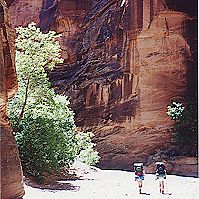
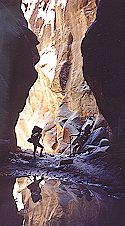
My first trip into Paria Canyon was in the company of Doug Minderlen and Tim Lange, two Honeywell co-workers. We hired a driver to shuttle our
vehicle the 90 miles from our starting point at Wire Pass trailhead to our exit point at Lees Ferry. This plan allowed us to walk through Buckskin Gulch and
downstream through Paria Canyon, to its outlet at Lees Ferry, and have our vehicle waiting for us at the end, 43 trail miles away. It was well worth the
$50 shuttle fee to avoid having to drive two vehicles up from Phoenix.
Wire Pass provided a tantalizing preview of what was to come. After walking for a mile across open, hot terrain, we finally entered our first slot, which was
short, but very tight. We were forced to turn sideways to squeeze through the narrow crevice and even then, our backpacks scraped the sides. Once
through Wire Pass, we entered Buckskin Gulch. Our spirits and our expectations were high and we were excited with the anticipation of what lay ahead.
The Gulch would not let us down.
The Buckskin started innocently enough, with casual walking through a stone corridor about 10 feet wide, with side walls ranging from 30 to 50 feet high.
Gradually, the canyon walls gained height. The width of the slot varied. It became only 4-5 feet wide most of the time, with infrequent "openings" up to 20
feet wide. After more than a mile of walking through the narrow, dry passages, we entered the first of the pools. Shallow mudholes came in rapid
succession. One, two, three.... five.... ten.... 24 in all. These ranged from 1 to 3 feet deep, 10 to 30 feet long, and had a consistency varying from
thin, brown water to thick, mucky, boot-sucking, pudding-like goo, depending on the particular mudhole. All were cold.... and all were fun!
 �
�
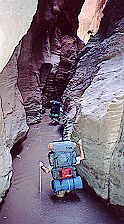
After 7 miles of walking through the continuous slot, we arrived at the "Middle Trail", which provides the only easy access to the benchland above. We
dropped our packs and went up to explore. After hours in the cool shade of the Buckskin, we were caught off gaurd by the blistering heat of the brushy,
desert terrain outside of the Gulch. The temperature in the Buckskin had been consistently in the 60's and 70's, but the temperature above was well over
100 degrees. Shortly, we scurried back into the Gulch to prevent overheating. We spent our first night within the confines of the Buckskin near Middle
Trail. A nearby pool of thin brown water provided us with a welcome and surprisingly acceptable bathing opportunity.
On our second day, we continued downstream through Buckskin Gulch, still 5 miles from its confluence with the Paria. Within an hour, the pools started up
again like the previous day. After wading through a dozen more pools, we arrived at a formidable rockjam that clogged the canyon floor. We scouted
around and then cautiously made use of an already-present rope to descend a 20' drop that provided the only acceptable way past the rockjam. The
pools continued, this time progressively longer, deeper, clearer and colder. Some were up to our waists, then to mid-chest, then to upper-chest. Finally,
we reached the pool that we had heard about from a ranger -- the one that required swimming. We had brought an inflatable raft for the purpose of floating
our packs and this was the time to use it. The pool was over our heads, very long, and very cold! It snaked out of sight around a distant
corner. We floated our packs, one at a time, and successfully got through it while keeping our gear dry. Upon exiting, we were very chilled in the
60 degree temperatures of the dark, deep slot canyon.
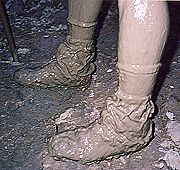
Fortunately, the Paria confluence was not far and with it came areas of bright sunlight to warm us up. After cleaning up, we continued downstream. We
were out of Buckskin Gulch and walking through the Paria Canyon river bottom. The canyon slowly widened, but the walls became even higher and
portrayed a magnificence of a different feel. We were the only people around and it felt as though we were walking through paradise. Ten miles of
blissful walking, with literally hundreds of wet, shallow stream crossings, brought us to our second night's campsite near a place called Judd Hollow.
Day 3 was hot and brutal! We walked for hours, in and out of the flowing stream, in the direct, searing sunlight and 105 degree temperatures.
Finally, at 5pm, we reached our destination of Lees Ferry and the end of the hike. Our vehicle was waiting for us as promised.
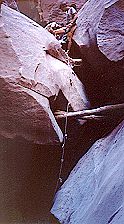 A tricky descent at the Rockjam |
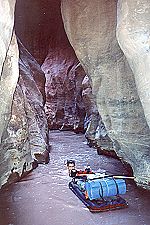 Floating our packs and swimming "the long hole" |
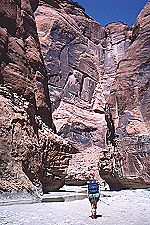 Paria Canyon below the Confluence |
October, 1995
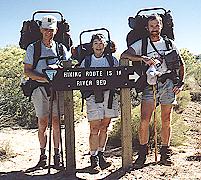
I visited Paria again in 1995, this time accompanied by my parents, Ralph and Millie Wyant. We began at White House trailhead and backpacked
downstream through the Paria River to a campsite near the exit of Buckskin Gulch, i.e., at the Confluence. We would spend two nights here and explore
the lower end of Buckskin Gulch on the middle day. The didn't really know what to expect, but are generally game for just about anything.
However, they were a little taken aback by the need to wade through the river in their hiking boots. The water depth was fairly shallow, ranging from
1 to 2 feet deep, and 10 to 20 feet wide. It was tame enough. In the 7 miles from the trailhead to the confluence, we found it necessary to wade across
the river, from one side to the other, 125 times. After their inital discomfort and uncertainty of wading, they came to enjoy it and we all had a great time.
It is after all, like being a kid again!
We arrived at the Confluence and set up camp. No one was around. After a pleasant and restful night, Day 2 arrived and was spent exploring
Buckskin Gulch. The Gulch is a special place and we were all rather overwhelmed by the beauty of it. After another pleasant and serene night, we
packed up and headed back out to the White House trailhead, via another 125 stream crossings. The following photos were taken along the Paria
between White House trailhead and the Paria/Buckskin Confluence.
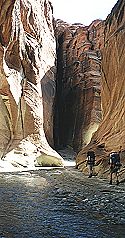 Downstream from White House trailhead |
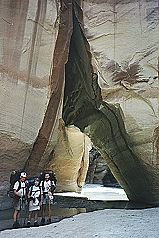 Sliderock Arch |
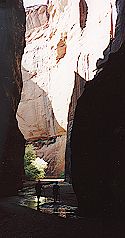 Walking in the stream |
October, 1998
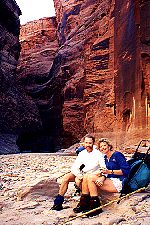
Cindy and I spent three days in Paria Canyon in October, 1998. We entered at White House trailhead and walked downstream through the Paria
riverbed, wading the stream approximately 120 times. When we arrived at the Confluence, the campsite of 1995 looked quite unappealing due to
mud, dampness and cold. We decided instead to walk 1/4 mile up into Buckskin Gulch and check out a campsite that a ranger had told us about.
The site we chose was atop a high hill, perhaps 50' above the canyon bottom and very safe from any possibility of flooding. Although good weather
was forecast, one must always be aware that an unexpected flash flood could have catastrophic results.
We spent two nights at our high campsite and explored the lower Buckskin on the middle day, walkiing a few miles up-canyon to the Rockfall.
The canyon was damp, muddy, and seemed rather depressing to us on this particular trip. Our drinking water was obtained from a small trickle of
clear water that came from springs in the lower Buckskin. Although there was plenty of water 1/4 mile from camp, in the Paria river, that water had
a brown, silty appearance that showed no improvement after filtering. We opted for the clear trickle near our camp. We were careful to
avoid the occasional patches of quicksand near the Confluence . Although quicksand was obviously present, it did not appear to be of the
life-threatening variety. One might sink slowly for several seconds and then step right out of it.
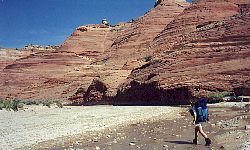
On our third day, we broke camp and walked back to the Confluence and upstream in the Paria to exit at the White House trailhead where we had began
our journey. After two nights and one day in the dark, damp gorge of the Buckskin, the abundant, glorious sunshine of the broad Paria felt especially welcome.
